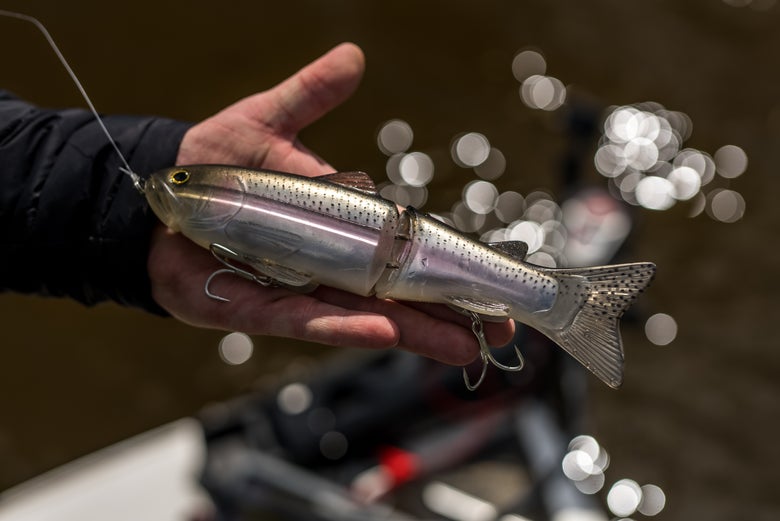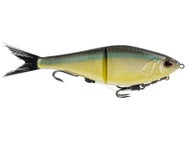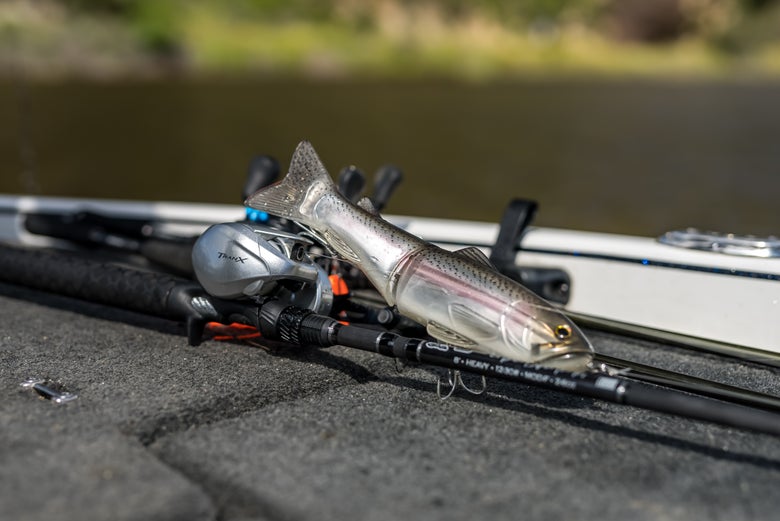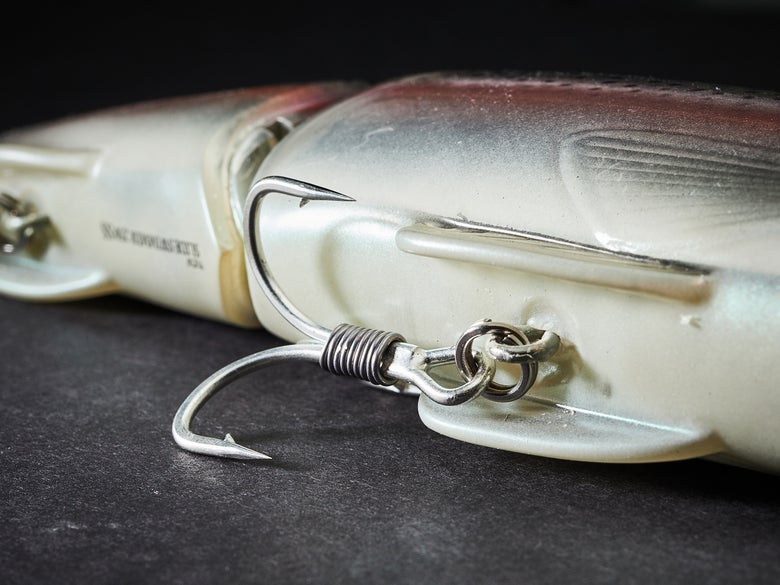Glide Bait Gear Guide
There’s no denying the incredible drawing power of a glide bait, and when you commit to throwing one, they afford ample opportunities to potentially catch the fish of a lifetime. Categorized as a single-jointed hard-bodied swimbait, glide baits are used to imitate large forage like trout, hitch, perch, or gizzard shad, and are known for producing a sweeping S-shaped motion that opportunistic bass can’t resist inspecting.
Under the right conditions, a glide bait can be an effective tool for catching numbers of fish, but most importantly, they excel at isolating and engaging large fish, as their mesmerizing action encourages them to follow even when they are not hungry. Glide baits can be an expensive and overwhelming bait category to break into, so our goal is to provide a good starting point for choosing the ideal setup, go over modification and rigging methods, and offer up some useful tips and tricks so you hit the ground running!
Glide Bait Rods
Because glide baits can vary greatly in size and weight, it’s important to match the power and length of your rod to the size of the lure you intend on throwing. When starting out, it’s a good rule of thumb to make sure the bait you are throwing lands near the middle of the rod’s lure weight rating. So, if your bait weighs 4 oz, the ideal weight rating would be around 2 to 6 oz. Rod length typically correlates to the size of the bait you are throwing and angler height, however most rods land somewhere around 7'4" to 8' in length.
With most power ratings ranging from heavy to XXH, you want to let the size of the bait dictate the power. If you are using small to medium-size glide baits (4" to 7") choose a rod on the lower end of this spectrum, and as you move into magnum-sized glide baits look to increase rod length and power accordingly. A swimbait rod with a moderate or parabolic bend is crucial for keeping the treble hooks pinned, and a longer handle allows you to tuck the rod under your armpit so you can simply rotate your torso when you have a bite for added leverage with sweeping hooksets.
Glide Bait Reels
Cranking power, high-speed gear ratios, and copious amounts of line capacity are most commonly associated with glide bait fishing reels. For small to medium-sized glide baits, most anglers opt for 200 to 300 size baitcasting reels for better palmability, while magnum glide baits may require a 400 size reel to ensure you have enough line capacity to make a long cast without sending out all of your line. A 7:1 gear ratio or faster provides the speed to pick up line quickly and efficiently during the retrieve and will help you impart action with small handle turns that make glide baits dart erratically and trigger aggressive reaction bites. It's important to note that a 400 size reel with a large spool and 5:1 gear ratio may pick up the same amount of line as a smaller reel with a higher gear ratio, so you’ll want to take IPT (inches per turn) into consideration when looking at reels.
Glide Bait Line
Heavy fluorocarbon lines are a popular choice among anglers for targeting the biggest and smartest fish in the lake with oversized baits. Fluorocarbon line turns virtually invisible underwater and provides minimal stretch to help you quickly and reliably bring big fish back to the boat. Being a highly visual and mostly sub-surface presentation, most prefer using fluorocarbon in the 15 to 30 lb range for glide baits, but much like your rod selection, the ideal line rating is always dictated by the size of the lure you are using. Over time you will develop your own preference, but as a general rule of thumb use 15 to 17 lb test for 4" to 6" glide baits, 20 lb test for glides that are 7" to 10" in length, and 25 lb or more for magnum glide baits that are over 10" in size.
Glide Bait Modifications & Rigging
Most glide baits are made with such close attention to detail that they typically come with high-quality stock hooks, but if you are in doubt about the sharpness or if the hooks have simply dulled from fishing, always sharpen or swap them out. Sharp, stout trebles are particularly important with glide baits in order to get good hook penetration and provide enough power to grind big fish back to the boat. Glide baits naturally have a tendency to rise during the retrieve, so if you find your glide bait coming to the surface too quickly, try using suspend strips or wrapping lead tape around the treble hooks to dial in the ideal depth and sink rate for the day. Lastly, consider adding a split ring or heavy-duty snap to your line tie to keep things loose and maximize the wide side-to-side swimming action of your glide bait.
Glide Bait Tips & Tricks
The best way to learn how to fish any glide bait is to study how it reacts in the water based on what kind of action you impart. Try playing with retrieves. Pump the rod as you reel. Speed it up. Slow it down. Give it a yank. Incorporate a pause. The goal is to try and find a retrieve that will trigger a bite and be able to replicate that action when you can’t see your lure in the water. When you get a follower, avoid letting the bait stall out. Instead, maximize the length of your retrieve with a quick twitch and pause, and take note of how the fish interacts with your bait. Fish that are hooked on glide baits are often lost when they jump or are given room to fight, so when you hook a fish keep a good bend in the rod, position your rod tip toward the water, and grind the reel handle until the fish hits the net.
Glide Bait Colors
When selecting the color of your glide bait, always consider what types of large forage live in the body of water you are fishing, as the old adage of ”match the hatch” usually applies. If your lakes are regularly stocked with trout, try using trout colors. If your waters have gizzard shad, the most productive colors may be baitfish or shad patterns. During the spring, a glide bait is a very effective tool for locating fish when they are spawning, so try using flashy or bright colors to draw fish from greater distances and generate more followers. With more than 10' of visibility, it’s usually best to stick with natural colors, and when there is a little stain in the water or you’re fishing dark overcast skies, bone is a great color option to provide some added contrast.
Final Thoughts
Glide bait fishing is a very exciting way to fish, as the bites are often big, and they are among the few lures that provide opportunities for the angler to watch when they eat and impart that little extra action to get them to commit. Don’t be discouraged when more fish follow your lure than bite it; glide bait fishing is all about timing the weather conditions, profile, color, and retrieve to convert those followers into biters!

























































































































































































































































